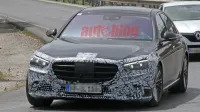2021 Mercedes-Benz S-Class bringing powerful engines and heaps of tech to U.S.

Mercedes-Benz hosted media for ride-alongs in the 2021 W223 S-Class, and the initial write-ups indicate it could take six months to figure out everything Stuttgart engineers put into the best-selling full-size luxury sedan. The least complex aspect is the three powertrains on the way for non-AMG models, the same number as the current sedan as outlined by Motor Trend. The base model is an S 500 that swaps the 329-horsepower 3.0-liter V6 in today’s entry-level S 460 for a 3.0-liter inline-six with 429 hp plus 21 additional ponies from Mercedes’ EQ Boost mild-hybrid system. A step up from there is an S 580, increasing the output of today’s 463-hp twin-turbo V8 to 496 hp plus a 20-hp EQ Boost system. At the top comes the S 580e plug-in hybrid with around 500 combined horsepower, which is 31 hp up on today’s S 560e. The output comes from a 3.0-liter inline-six ramped up to 362 hp, and a 140-hp e-motor. Torque holds steady at the same 516 pound-feet as the S 560e, but the 28-kWh battery in the 2021 PHEV should be good for about 60 miles on electric power, more than doubling the sedan’s present EV range.
Beyond that come the Maybach and AMG models. The former sticks with a V12 for its S 650 trim. The latter will offer two trims, an S 63e with about 600 hp, and an S 73e with more than 800 horses.
Outside, both the standard and long-wheelbase cars get longer wheelbases. The shorter model adds 2.8 inches between the wheels to grow to 122.3 inches. We only get the long-wheelbase sedan in the U.S., and it adds two inches between the axles, now out to 126.6 inches. To get these behemoths through tight spaces, Mercedes has made rear-wheel steering standard throughout the range. MT says that the standard RWS comes with thinner tire selections, and can turn the back wheels in the opposite direction by a whopping 10 degrees up to about 35 miles per hour, after which the rears turn the same direction as the fronts. On S-Class models with wider tires, MT says the RWS only turns the back wheels up to 4 degrees. Car magazine’s description of the system doesn’t mention tire size, but characterizes the 4.5-degree RWS as “the entry-level version.” The more extreme take reduces the S-Class’ turning circle to under 34 feet, meaning it can flip a U-turn in the same space as an A-Class.
A very short list of innovations coming to the new sedan includes an optional E-Active Body Control hydro-pneumatic suspension that debuted on the GLC. It can individually lift a wheel over a road imperfection, or lift the entire vehicle 3.2 inches when sensors detect a side impact so that the side rails take more force instead of the doors. The seats contain 17 motors, and the seat controls on the doors no longer move but are capacitive and permit finer adjustment. There’s Level 3 autonomy and the ability for the car to pull itself to the side of the road, plus new sensors in the steering wheel rim that give finer detection of a hand on the wheel. More sound deadening and a U-shaped, double-walled engine bay help make the sedan even quieter inside. Sensors in the cabin recognize occupants based on either voice, fingerprint, or facial recognition, and know which seat they’re in. Ambient lighting is used to communicate, with a section above the center screen glowing when an occupant speaks to the car, or another section of lighting in the door illuminating to warn of passing traffic when parked and an occupant is about to open a door.
Check out the full write-ups at Motor Trend and Car. The sedan debuts in a little more than a week, on September 2. There’s going to be a lot to learn.
Related Video:




